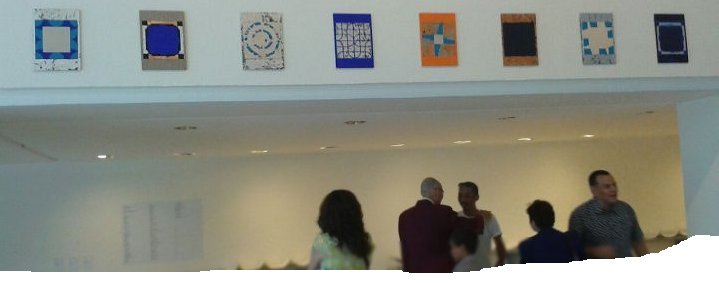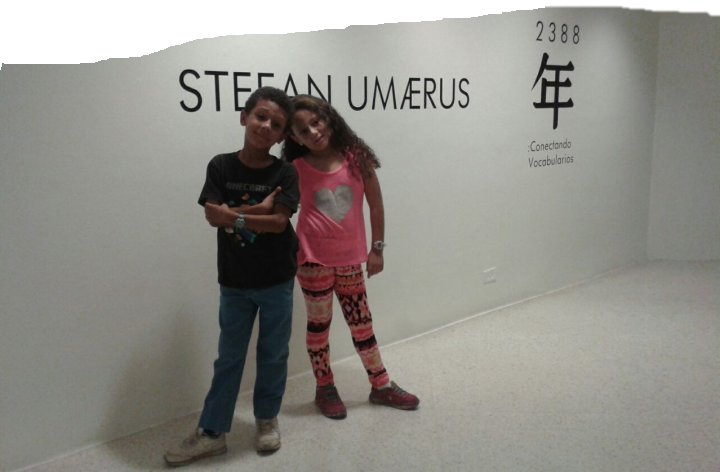
PRESS RELEASE
Teresa
Quilez
Prensa, Museo de Arte Contemporáneo,
Caracas, Venezuela.
Exhibition 2388: Connecting Vocabularies. Stefan Umærus
The Museo de Arte Contemporáneo, located in the cultural zone of Parque Central, Caracas, opens “2388: Connecting Vocabularies”, an exhibition by Stefan Umærus, who has created a poetic visualization of connected worlds and fused vocabularies in painting, poetry and a diary. Inauguration: Sunday, June 5th, 2016, 11:00 am, Sala 7.
The exhibition allows the public to explore the particular universe of this creator. The art project is based on the poems and diary Stefan Umærus wrote diary during his time as a student of the Mandarin language at the University of Foreign Studies, Beijing, between 1988 and 1989, the period just before the events on Tiananmen Square, on June 4th, 1989.
Visitors can enjoy paintings, presented as fourteen works in large format, twelve panels of poetry, a handwritten book by the artist, a diary, poems and eight abstract paintings in small format. It should be noted that the poems and diary were originally written by hand, day by day, as the events unfolded. The paintings were made in New York in 1991.
In this regard, we talked with Umærus, who before starting the interview emphasized that in this project has worked in conjunction with his wife, the Venezuelan Chely Depablos, whom he married in New York in 1991.
The seed of this curatorial discourse has it's cradle in China. About this, he tells us that the seduction of the Asian country was almost immediate: "My intention was to be immersed in the culture of China. When I was at the language school, a student movement began and I found it interesting to make it part of my project. For this reason, I wrote a diary, poems, and added photos to the documentation. "I loved the city and the culture of Beijing. It was fascinating and the most amazing was that sometimes they deified me. I was very happy at the time, had many friends". A happiness that has been a constant in his life, evident in his smile.
When referring to fundamental influences in the development of his artistic evolution he mentions the versatile Ezra Pound, pillar of modernism, poet, musician, essayist and critic. Moreover, he remembers one of the texts he read during his childhood, the theatrical piece Père Ubu by Alfred Jarry, cornerstone for the development of the artistic movement referred to earlier. He read Pound extensively, long before the magical country, China, where he began the fusion of disciplines.
The artist explained that the number in the title, “2388”, refers both to what we have become humans, a series of numbers in documents, as well as to time past, the seventeenth century, and to four hundred years years into the future. As stated in the catalog text: "in an allegorical anticipation of the transmuted future, Umærus revives the premise of the seventeenth century French court series La Galerie de Phaéton by Sébastien Bourdon.”
The artist who considers himself adopted by Venezuela – he has 25 years married to a Venezuelan - as well as adopted by other countries, tells us that the gift for painting has followed him since he was a child, "I was very creative" and laughs especially by recalling when he was about four years old, at preschool, the teacher asked the children to copy a design of a boat. He was enchanted by the colors, but his drawing was not exactly as the original. All the other kids made an exact copy of the original, and made fun of him.
As time went by, the gift for painting began to be formal beyond the age of twenty. Although the fusion with poetry was much later, he felt seduced by the world of letters from an early age: "Since I was a child I used to read a lot in the library. At the age of fourteen, I remember reading “L' Opoponax”, novel by Monique Wittig, and “Père Ubu” by Alfred Jarry.”
The universe of the bards fascinated him "For me, the poetry is to express what I have in mind, in my feelings, is like a different dimension" and adds through poetry "I do live things that conventional people do not, and that is what I also express in painting".
From a family dedicated to science, the inspiration from his family was fundamental, "they worked throughout the world, traveled to different countries" and adds that with them he had the opportunity to experience and appreciate multiple cultures, and to learn languages.
The adventure in China of this creator began after having passed before his trip to
the Asian country, Le Marais, a seventeenth-century district in Paris, France, where he exhibited at Le Centre Cultural Suédois, with an exhibition entitled “Epsilon Lyræ”. Inspired, he traveled through the then USSR with the Trans-Siberian Express and then studied the Mandarin language for one year at the Beijing Foreign Studies University. The project of this artist is an eloquent elixir not to be missed.
(FIN/ WWF/MAC/ Teresa Quilez)
(Caracas,
June)
“2388: Connecting Vocabularies”, by
Stefan Umærus, a curatorial discourse, is the title of
the most recent exhibition at the Museo de Arte Contemporáneo,
for the public to enjoy in Sala 7.
To go deeper in this project we talked with the wife of the
artist, the Venezuelan Chely Depablos, who has jointly developed
this proposal with her consort.
She explained to us, that the project is a message of
reconciliation and peace, which began in 1990 and merges two
experiences lived by Umærus:
The historical events in Tiananmen
Square in China, June 4th, 1989, which occurred when the artist
was living there, as a student of Mandarin language at the
Beijing Foreign Studies University, 1988-1989.
He transmuted the historical events in painting poetry, and an
artist's book.
The experience in the Marais,
Paris, France, inspired him on the premise of the Seven Arts and
the Seven Virtues, a XVII century French Court painting
series, the Galerie de Phaeton, by Sébastien Bourdon, created to
educate and inspire. Stefan wanted to make a replica,
addressing 400 years in the future and this is why the
project, based on his experience in China, is called “2388:
Connecting Vocabularies”,
It should be noted that, as Umærus himself states, although this
project is immersed in his specific experiences, the inspiration
is modernist and post modernist art, a universe he is, as an
artist, totally informed by.
Fourteen works in large format and twelve panels with poetry, a
handwritten book by the artist, a journal, poems and eight small
format abstract paintings, are included in this exhibition,
where we emphasize that the poems and journal were originally
written by hand, day by day, as the events unfolded in Beijing.
The paintings were made in New York in 1991.
Depablos evoked with emotion her
story with Umærus. She met him on March 15, 1990 during a
working dinner where there were several artists. “I sat next to
him and we never split up.”
The gallery they had together In Soho, New York, and their
professional evolution are some of the memories she told us.
She arrived to Chicago, United States in 1980 to study
languages, and worked at the Fundación Gran Mariscal de
Ayacucho. She studied arts administration at the university when
was transferred to the Big Apple, and become a lover of culture
and it's artistic expressions.
She was devoted to the gallery and subsequently to perfume,
another sublime inspiration for the spirit to cherish our
senses.
Undoubtedly, this is an exhibition that will connect you with
multiple vocabularies and languages, poetry and painting, which
you should not miss.
(FIN/ WWF/MAC/
Teresa Quilez)
--
Mgter. Teresa Quilez
MAC Press
CNP 6024
Phone: 0416 6328519
e-mail: Tquilez@gmail.com
Translation
from Spanish by Renny Arrieta, 2016, and by Stefan Umærus, 2017.
